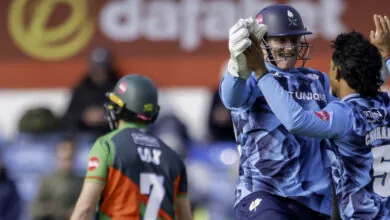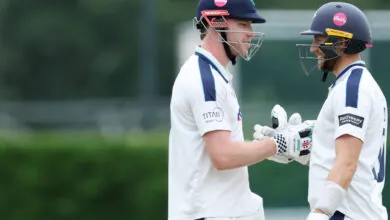The year of 1971 saw the debuts of three Yorkshire cricketers as well as one significant retirement and one departure. Paul Dyson looks back at the quintet’s varied careers.
Two cricketers made their debuts on May 12th, 1971 against Oxford University at The Parks and opened the bowling together in what was Yorkshire’s third first-class game of the season. In the first innings each bowler took two wickets; Peter Borrill was aged only 19, took two further wickets in the second innings and was retained in the side for the Championship game at Hove against Sussex. Tony Nicholson and Richard Hutton returned to the team for this match and so Borrill received less opportunity, taking only one wicket and the surprising outcome was, given his age, that he never played for Yorkshire again. Born in Burmantofts, Leeds in 1951, Borrill had a long career with Leeds as a quality medium-fast bowler. He also spent time with Darlington in 1973, as professional, as well as Hanging Heaton and Old Modernians.
The other pace bowler making his debut at Oxford was Arthur Robinson. Although taking only one wicket in the students’ second innings it was he, rather than Borrill, who retained his place as the opening bowler – with Nicholson. Being a left-arm medium-fast bowler, he brought variety to Yorkshire’s attack but played in only one further first-class game in 1971, making three for the season, and made only one appearance in the following year. The 1973 season, however, was very different as he was given a longer run in the side, playing in ten first-class matches and 12 one-day games (he had previously appeared in just three in two seasons).
Robinson came from the northern part of the county – Brompton, near Northallerton to be precise, being born in 1946. His first two clubs were Harlsey, for whom he played as a slow bowler, and Northallerton but then had two years with Leeds, this period coinciding with his first two seasons in the Yorkshire team. He always gave his all for the side, was tall and strongly-built, and in what was a poor attack by Yorkshire’s standards, soon found himself leading it.
Robinson had his best season in 1974 when he took 43 wickets in first-class cricket and 28 in List A games. In that season he took a career-best six for 61 in a Championship match at The Oval against Surrey and the following day took four for 25 on the same ground against the same opponents to record his career-best in the shorter format. In 1976 he was awarded his county cap but did not play a full season in the following year so decided to return to Northallerton. There he became the club’s groundsman and was able to continue his involvement in the game. His Yorkshire career had ended with him taking 196 wickets in 84 first-class matches and 105 in 92 List A games. Not renowned for his batting, he made his highest first-class score of 30 not out at Cardiff against Glamorgan in his final season. What made the innings noteworthy was that he took part in a tenth-wicket stand of 144 with Arnie Sidebottom – at the time Yorkshire’s second-best in its history – which ended with the latter being run-out.
Two months on from the debuts of Borrill and Robinson came the first appearance of another pace bowler. Howard Cooper was born in Great Horton, Bradford in 1949 and played his early cricket with Bankfoot; his debut for Yorkshire came in a John Player League match against Kent at Maidstone and his maiden first-class match was the Roses game at Bramall Lane, Sheffield at the end of the month. Another medium-fast bowler, he suffered from regular back trouble and this had twin effects on his performance: he had to modify his action to a certain extent; the resultant concentration on line and length made him more effective in limited-overs cricket to which his economy rate of fewer than four runs per over testifies.
Cooper never played a full season for Yorkshire but was probably at his best in 1975 and 1976 when he took over 40 wickets in first-class cricket in each of these seasons. In the first of these two campaigns he achieved his career-best in both formats. Figures of eight for 62 in the Championship against Glamorgan at Cardiff came when he was able to exploit a slow surface to full advantage and his six for 14 in a JPL match against Worcestershire at Worcester have been beaten only twice by Yorkshire bowlers in List A cricket. He left Yorkshire at the end of 1980 having taken 227 wickets in 98 first-class matches and 177 in 142 List A games. Initially he returned to his Bradford League roots, firstly with Pudsey St Lawrence and then with Bradford before playing for Killinghall in the Nidderdale League.
The two players who each played their final games for Yorkshire in 1971 did so in the latter part of the season. Having been usurped for the wicket-keeper’s place in the team by David Bairstow in 1970 (following the retirement of Jimmy Binks) Neil Smith made his final appearance for the White Rose county in mid-August. His only game of the season in either format was against the touring Indians. He took one catch, did not bat and, thereafter, was able to move to Essex where he had a successful career.
Mid-September was the time, Bradford the venue and Northamptonshire the opponents in what was the final game of one of Yorkshire’s most distinguished servants. The venue was most appropriate as Dirk Hill, Bradford was where Doug Padgett had been born – in 1934 – and it concluded his 21-season career which had begun with him making his debut 44 days short of his 17th birthday, such had been his promise. In 1951, when this auspicious event took place, he became Yorkshire’s youngest-ever player having played for Idle when aged only 13.




